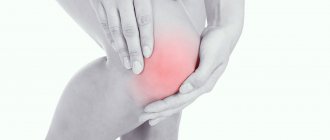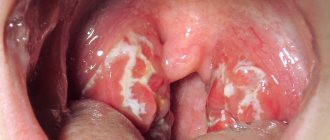What is fluid accumulation in a joint?
The accumulation of fluid in the joint is considered one of the symptoms of hydrarthrosis or dropsy - a peculiar syndrome in which the volume of the joint increases due to the formation of synovial fluid in its cavity.
Most often, this syndrome is observed in the knee joint, less often in the ankle, elbow and others. In this case, there may be a restriction in joint flexion; the intensity of pain depends on the amount of fluid and the degree of stretching of the joint capsule. An increase in local temperature is not observed unless the inflammatory process has begun.
Varieties
The disease belongs to the category of pathologically dangerous, the lack of timely diagnosis and treatment of which can lead to serious impairments in a person’s life activity and quality of life.
Today, it is customary to distinguish several types, each of which has specific symptoms and prognosis. Let's look at each type in more detail.
Spicy
A type of pathology involves the accumulation of a large amount of fluid, which contains a large amount of proteins and blood impurities. Overfilling of the synovial bursa leads to swelling of its walls, which provokes pain of varying intensity.
Chronic
Synovial fluid contains a high concentration of fibrillar proteins, which indicates irreversible processes occurring in the tissues of the joint membrane.
Destruction of the internal cavity of the joint capsule leads to compaction of the tissues of its walls, which causes the formation of intra-articular bodies.
Purulent
Damage to the joint capsule, suggesting the presence of purulent impurities in the synovial fluid, which causes a change in its structure and the onset of the inflammatory process.
Lack of therapy leads to the spread of the lesion to other structural components, provoking the development of acute purulent arthritis.
Causes
The accumulation of fluid in a joint can be a consequence of a disease, but the most common cause is injury. These include:
- Injury – sprain, ligament rupture. This can lead to a buildup of fluid that becomes infected after a viral illness.
- Various joint diseases, including gout or arthritis.
- Lupus erythematosus.
- Bursitis, which is common in dancers or athletes.
- Incoagulability of blood and others.
Important! These reasons must be mentioned when visiting a doctor, this will help to correctly establish a diagnosis and prescribe competent treatment.
Hemarthrosis
Hemarthrosis
- trauma – sports, domestic, professional, criminal, road traffic and any other;
- surgery – sometimes hemarthrosis occurs as a complication of arthroscopy or open surgery on the joint.
There are internal reasons that increase the likelihood of hemarthrosis. In some people, even minor trauma results in severe bleeding. First of all, the risk factors are disorders in the blood coagulation system. The cause may be a congenital deficiency of coagulation factors, acquired diseases (for example, cirrhosis of the liver), a decrease in the number of platelets in the blood (thrombocytopenic purpura, a history of severe bleeding, disseminated intravascular coagulation syndrome).
The main types of injuries that most often lead to hemarthrosis:
- meniscus damage;
- knee ligament rupture;
- damage to fatty bodies;
- intra-articular bone fractures.
Both direct (a blow to the knee) and indirect (twisted leg) injury can lead to severe damage with bleeding.
Classification
The fluid that accumulates in the joint cavity can be classified by its nature into exudate and transudate. Accordingly, exudate is associated with the occurrence of inflammatory processes and comes in several types:
- Serous.
- Purulent.
- Hemorrhagic.
- Frail.
Transudate is formed for other reasons that are not related to inflammation, but are associated with circulatory disorders and other abnormalities.
Composition and functions of joint fluid
Synovial fluid is a unique medium in its biological composition and properties and is contained in the cavity of the joints.
The composition of SF is similar to plasma, however, being a blood transudate, it has several differences. Synovia contains less protein and contains hyaluronic acid (HA). The joint fluid has special barrier properties that prevent the penetration of cells with a relative molecular weight of more than 160,000. This explains the smaller amount of proteins in the composition of the joint fluid.
Three sources take part in the formation of synovial fluid: blood transudate containing water, proteins and electrolytes; hyaluronic acid and proteolytic enzymes (secretion products found in the synovium cell membrane); proteoglycans and glycoproteins regularly supplied during the normal functioning of the SG (formed in the process of replacing old synovial cells with new ones).
Composition and functions of joint fluid
Due to its unique physicochemical properties, SF performs three functions: it participates in metabolic (metabolic), protective (barrier) and biomechanical (protective) processes of the body.
Modern researchers identify several theories of how joints are lubricated: “lubrication by sweating,” “booster,” and “lubrication by a compressed film of liquid.”
Pathologies
The accumulation of fluid in the joints is a health hazard and can lead to the development of the following pathologies:
- Hemarthrosis is formed due to damage and blood flow into the joint.
- Arthrosis is the most common pathology and occurs as a result of mechanical damage or age-related changes.
- Arthritis can occur for a variety of reasons, including infections or allergic reactions.
- Synovitis is an inflammatory disease.
- Bursitis can develop due to injury or after an infectious disease.
Symptoms of lack of joint fluid
Restoring normal levels of joint fluid directly depends on the etiology of inflammation. The cause can only be determined by a specialist: an osteopathic surgeon, a rheumatologist. Lack of synovium production is caused by the following diseases:
- Arthritis . It is an imbalance of synovial fluid - its excess or deficiency caused by inflammatory processes.
- Sacroyelitis . It may appear due to pregnancy, infection and frequent physical activity. This is an inflammation that develops in the iliac joint of the hip bone.
- Systemic lupus erythematosus . An autoimmune disease that affects joints, blood, and vision.
- Osteoarthritis . A disease that results in thinning of the joints, leading to their deformation and gradual destruction.
- Still's disease . A form of arthritis, the development of which is characteristic of childhood and adolescence.
- Ankylosing spondylitis . Chronic inflammation, most often affecting the sacroiliac joint, which connects the spine and pelvis.
- Infectious lesion . The penetration and reproduction of pathogenic organisms leads to a decrease in life expectancy.
- Oncological diseases.
Other factors leading to a decrease in synovial fluid:
- frequent loads;
- excess weight;
- lack of fluid in the body;
- unbalanced diet;
- weak immunity;
- helminthiasis;
- consequences of injuries.
With a lack of synovium in the joint, the symptoms are different. The list of manifestations depends on the etiology, which can only be diagnosed by a doctor. The most common symptoms are:
- Pain syndrome . Occurs when there is a lack of HAA and collagen, as well as polysaccharides, leading to joint friction. The result is sharp and stabbing pain, a feeling of tightness and burning.
- Unpleasant sounds . The functioning of the joints due to a deficiency of synovial fluid is accompanied by clicks, creaks, and crunching sounds.
- Decreased mobility . Due to a lack of fluid, the surface of the joints rubs during operation and begins to become inflamed, which leads to tumors, pain and swelling.
- Deterioration in general health . Friction of the articular surfaces causes discomfort, pain, fever and chills, and decreased performance.
- Redness of the skin around the site of inflammation.
- Bone growths . The appearance of bone processes - osteophytes - is likely.
Diagnosis of the causes of fluid accumulation in the joint
Diagnosis of this pathology consists of an initial examination of the patient by a specialist, for example, an orthopedist or traumatologist. After an external examination, palpation and questioning of the patient, the doctor makes a preliminary diagnosis and refers the patient for additional examination for clarification:
- x-ray,
- Ultrasound of the joint,
- MRI of the joint
- joint puncture and others.
Reference! To identify hidden infections, a general or extended blood test, ECG and blood type identification may be needed.
After carefully studying the examination data, the specialist will prescribe comprehensive treatment depending on the cause of the disease.
Surgery
The minimum intervention in the body is arthroscopy, a procedure to clarify the condition of the organ, clarify the diagnosis, and also perform a biopsy of damaged tissue. The therapeutic effect of arthroscopy is to reduce swelling due to drug treatment of the internal cavity of the joint.
Complete or partial removal of the affected tissue is carried out during synovectomy. The operation is indicated for patients with dangerous forms of the disease, an acute unpredictable course of the disease, as well as chronic, often recurrent synovitis. The operated joint is immobilized for a week, but movement is possible already on the second day after the intervention. Rehabilitation is long.
Which doctor treats fluid accumulation in a joint?
The accumulation of fluid in the joint is considered a fairly common problem, which, even in the absence of pronounced symptoms, requires immediate seeking qualified medical help. Like treatment of the spine, fluid removal from the joint cavity should be done immediately after the problem is discovered. You need to contact an orthopedic traumatologist who specializes in diseases of the musculoskeletal system and rehabilitation after surgical interventions.
In our Kuntsevo treatment and rehabilitation center, you will not only receive qualified assistance from experienced orthopedic traumatologists if fluid is detected in the joints, but you will also be able to undergo a full examination using the latest diagnostic equipment and, if necessary, recover in our rehabilitation center after injuries according to a specially developed comprehensive program .
The accumulation of fluid in the joint significantly reduces the patient’s quality of life. As a rule, a person cannot fully perform movements and complains of pain and discomfort in the joint area.
Important! This symptom cannot be ignored, because the progression of the pathology can lead to the development of chronic inflammatory joint diseases.
At the first signs of pathology, make an appointment with a qualified doctor - orthopedic traumatologist at the Kuntsevo Treatment and Rehabilitation Center, who will be able to fully examine the joint, find the source of the pathology and prescribe the correct treatment, in particular at the rehabilitation stage.
Sign up
Diagnostic methods
To identify the cause of the pathology and make an accurate diagnosis, it is necessary to conduct a comprehensive diagnosis. After collecting anamnesis and systematizing the data obtained about the patient’s complaints and previous diseases, a visual examination is carried out. In this case, the injured knee is palpated, the gait and the patient’s ability to straighten the joint are analyzed. The patient is asked to do:
- Puncture.
In this case, the surgeon numbs the pain, and then pierces the joint cavity with a thin needle, collecting the synovium. In laboratory analysis, attention is paid to the color, transparency and viscosity of the liquid. Next, it is subjected to microscopic and cytological examination to determine the cause of inflammation. The results obtained make it possible to choose the right treatment tactics. - MRI.
Using this method, you can see the structure of the synovial membrane. If there is liquid, the device allows you to estimate its quantity. Thanks to MRI, the specialist will receive a detailed description of the functionality of the joint, as well as information about the condition of the surrounding tissues, blood vessels, and nerve fibers. - Ultrasound.
Used to visualize changes in the thickness of the inflamed synovium. This is one of the signs of synovitis activity. At the same time, it is possible to examine in detail the structure of soft tissues and detect the pathological process at an early stage. - Arthroscopy.
This therapeutic and diagnostic procedure makes it possible to examine the affected joint, differentiate the nature of the lesion, and also study the relief of the synovial membrane along its entire length.
Based on these data, the specialist determines the diagnosis, clarifies the form and degree of development of the disease, and prescribes treatment.
Types of treatment for fluid accumulation in a joint
The accumulation of fluid in the joint can be treated in different ways, depending on the degree of advanced disease. Among the various joint treatment methods offered by the Kuntsevo Center, the following can be listed:
- Drug treatment, which consists of prescribing and taking medications and vitamins.
- One of the ways to treat joint diseases and relieve pain is blockade - special injections into the joint or periarticular tissue. This method of therapy is also used during the rehabilitation period after completion of treatment.
- ACP SVF therapy is the latest unique method for treating degenerative joint diseases. To carry out this type of treatment, it is necessary to extract the stromal-vascular fraction from the patient, then prepare a special composition based on it and introduce it into the affected area of the joint by injection.
Symptoms of synovitis of the knee joint
Common symptoms of synovitis of the knee joint, regardless of the etiology of its origin, include:
- swelling of the affected area;
- visually noticeable increase in the size of the affected area;
- mild/moderate pain;
- feeling of "fullness".
Specific symptoms of synovitis of the knee joint are determined by the type of pathology present and the degree of its development.
Symptoms of acute synovitis of the knee joint
With the development of pathology, the size of the joint of the lower limb noticeably increases in volume. The patient experiences an unpleasant feeling of fullness, as well as pain that intensifies when performing movements. Swelling is observed.
An important symptom is the voting of the patella (with external influence, it moves down until it touches the bone. After the influence stops, it returns to its original position).
In rare cases, general malaise occurs.
The severity of symptoms is determined by the amount of fluid accumulated inside the joint capsule.
Symptoms of chronic synovitis of the knee joint
The pathology of this type is characterized by a wave-like course, in which exacerbation alternates with remissions.
The symptomatic picture during an exacerbation is similar to acute synovitis, but is less pronounced. Additionally, the following may be observed:
- inactivity;
- dull, aching pain;
- increased fatigue when walking at varying intensity.
Symptoms of purulent synovitis of the knee joint
Local symptoms: noticeably enlarged joint, sharp pain, almost complete loss of mobility.
Unlike other varieties, purulent inflammation has clear symptoms, similar to those that occur during intoxication:
- increase in body temperature up to 40°C;
- chills, fever;
- the occurrence of neurological disorders;
- indigestion.
Articular symptoms can also be observed, which usually include swelling of the skin.
Products with high hyaluron content
It was already mentioned above that hyaluron is an integral component of joint fluid along with cholesterol. However, before you start increasing its amount, you need to make sure that there is a lack of it and that additional administration is necessary. The deficit of GUK can be judged by the following signs:
- sagging, tightness, dry skin;
- the appearance of wrinkles;
- loss of vision;
- creaking, crunching of joints.
If one or more signs are present, there is still no reason to panic. The fact is that hyaluron is contained in publicly available products, so its level can be restored. Where can you get GUK:
- jellied meat, jelly (jelly-like dishes);
- products containing starch (potatoes, corn) and dishes made from them;
- grape juice, raisins;
- soybeans
Lack of cholesterol can also be eliminated. Despite the fact that it is contained in acids and not in its pure form, we compensate for its deficiency through the following products:
- greenery;
- soy;
- oils
As an alternative to products high in hyaluron, you can take herbal tinctures. Collections from what nature provides also help normalize processes in the body.
For example, you can infuse lingonberry leaves in a water bath for 10 minutes to obtain a medicinal tea. To prepare a medicinal cinquefoil tincture, you will need to mix alcohol with its crushed roots in a ratio of 10:1 and keep them in the dark for 3 weeks.









